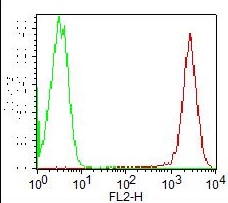Monoclonal Antibody to CD20 (Clone: B9E9)

Fig-1: Cell surface flow analysis of hCD20 on Raji cells using 0.5 µg/ 10^6 cells. Green represents isotype control (ABEOMICS); red represents anti-CD20 antibody (10-4155). Goat anti-mouse PE conjugated secondary antibody (ABEOMICS) was used.
Roll over image to zoom in
Shipping Info:
Order now and get it on Tuesday April 29, 2025
Same day delivery FREE on San Diego area orders placed by 1.00 PM
| Format : | Purified |
| Amount : | 100 µg |
| Isotype : | Mouse IgG2a, Kappa |
| Purification : | Protein G Chromatography |
| Content : | 25 µg in 50 µl/100 µg in 200 µl PBS containing 0.05% BSA and 0.05% sodium azide. Sodium azide is highly toxic. |
| Storage condition : | Store the antibody at 4°C, stable for 6 months. For long-term storage, store at -20°C. Avoid repeated freeze and thaw cycles. |
| Gene : | MS4A1 |
| Gene ID : | 931 |
| Uniprot ID : | P11836 |
| Alternative Name : | B-lymphocyte antigen CD20, B-lymphocyte surface antigen B1, Bp35, Leukocyte surface antigen Leu-16, Membrane-spanning 4-domains subfamily A member 1, CD_antigen: CD20 |
| Immunogen Information : | Lymphoblastoid cell line Daudi was used as the immunogen for this antibody. |
CD20 is clinically validated as an immunotherapy target for B-cell lymphomas and autoimmune diseases. CD20 consists of large, intracellular, amino- and carboxyterminal portions connected by 4 membrane-spanning domains. Its high expression on malignant B cells and its reported lack of shedding from the surface make CD20 an ideal target for antibody-mediated killing. Anti-CD20 antibodies are believed to mediate the therapeutic effect by activation of complement-dependent cytotoxicity (CDC) and largely by antibody-dependent cellular cytotoxicity exerted by recruitment of innate immune effector cells expressing the Fcgamma receptor IIIa.
FACS: 0.5-1 µg/10^6 cells
For Research Use Only. Not for use in diagnostic/therapeutics procedures.
| Subcellular location: | Cell membrane, Cell membrane |
| Post transnational modification: | Phosphorylated. Might be functionally regulated by protein kinase(s). |
| Tissue Specificity: | Expressed on B-cells. |
| BioGrid: | 107369. 15 interactions. |
|
There are currently no product reviews
|













.png)











